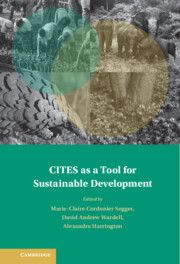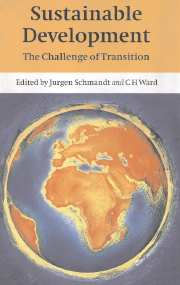Refine search
Actions for selected content:
258953 results for CITES as a Tool for Sustainable Development
Title match

CITES as a Tool for Sustainable Development
-
- Published online:
- 27 July 2023
- Print publication:
- 10 August 2023
Part V - Emerging Issues and Synergies for CITES in the Context of Sustainable Development
-
- Book:
- CITES as a Tool for Sustainable Development
- Published online:
- 27 July 2023
- Print publication:
- 10 August 2023, pp 385-470
-
- Chapter
- Export citation
2 - Origins, Evolution and Contribution of CITES to Achieving Sustainable Development
- from Part I - Endangered Species, Sustainable Development and the Law
-
-
- Book:
- CITES as a Tool for Sustainable Development
- Published online:
- 27 July 2023
- Print publication:
- 10 August 2023, pp 21-37
-
- Chapter
- Export citation
28 - New Directions for Law and Policy on Sustainable Development in the Context of CITES and Endangered Species
- from Part VI - Conclusions
-
-
- Book:
- CITES as a Tool for Sustainable Development
- Published online:
- 27 July 2023
- Print publication:
- 10 August 2023, pp 473-481
-
- Chapter
- Export citation
3 - Framework for making development more sustainable (MDMS): concepts and analytical tools
-
- Book:
- Primer on Climate Change and Sustainable Development
- Published online:
- 25 December 2009
- Print publication:
- 03 March 2005, pp 99-142
-
- Chapter
- Export citation
Foreword
-
- Book:
- Engaging Language Learners in Contemporary Classrooms
- Published online:
- 19 June 2021
- Print publication:
- 12 March 2020, pp vi-vii
-
- Chapter
- Export citation
Plant Genetic Resources and Plant Improvement as Tools to Develop Sustainable Agriculture
-
- Journal:
- Experimental Agriculture / Volume 28 / Issue 1 / January 1992
- Published online by Cambridge University Press:
- 03 October 2008, pp. 89-98
-
- Article
- Export citation
16 - Corporate Participation in Climate Change Mitigation in Developing Countries: ‘Green Capitalism’ as a Tool for Sustainable Development
- from Part III - Normative and Utility Perspectives
-
-
- Book:
- Corporate Social Responsibility in Developing and Emerging Markets
- Published online:
- 18 December 2019
- Print publication:
- 19 December 2019, pp 315-335
-
- Chapter
- Export citation
24 - CITES as a Tool for Monitoring and Adaptive Management
- from Part V - Emerging Issues and Synergies for CITES in the Context of Sustainable Development
-
-
- Book:
- CITES as a Tool for Sustainable Development
- Published online:
- 27 July 2023
- Print publication:
- 10 August 2023, pp 405-424
-
- Chapter
- Export citation
Invasive vertebrate eradications on islands as a tool for implementing global Sustainable Development Goals
-
- Journal:
- Environmental Conservation / Volume 47 / Issue 3 / September 2020
- Published online by Cambridge University Press:
- 13 August 2020, pp. 139-148
-
- Article
-
- You have access
- Open access
- HTML
- Export citation
Sustainable Development
-
- Journal:
- African Studies Review / Volume 41 / Issue 1 / April 1998
- Published online by Cambridge University Press:
- 23 May 2014, pp. 141-146
-
- Article
- Export citation
6 - Sustainable Development
- from Part II - Critical Engagement of and with Environmental Violence
-
-
- Book:
- Exploring Environmental Violence
- Published online:
- 06 June 2024
- Print publication:
- 09 May 2024, pp 135-155
-
- Chapter
-
- You have access
- Open access
- HTML
- Export citation
Part 4 - Sustainable Development
-
- Book:
- Economics and the Global Environment
- Published online:
- 06 December 2010
- Print publication:
- 09 October 2000, pp 459-460
-
- Chapter
- Export citation

Sustainable Development
- The Challenge of Transition
-
- Published online:
- 17 August 2009
- Print publication:
- 13 April 2000
Climate-smart socially innovative tools and approaches for marine pollution science in support of sustainable development
-
- Journal:
- Cambridge Prisms: Coastal Futures / Volume 1 / 2023
- Published online by Cambridge University Press:
- 22 March 2023, e23
-
- Article
-
- You have access
- Open access
- HTML
- Export citation
2 - On sustainable development
- from Part I - Sustainable Development: Theories and Practices
-
-
- Book:
- Sustainable Development: Asia-Pacific Perspectives
- Published online:
- 23 December 2021
- Print publication:
- 13 January 2022, pp 8-12
-
- Chapter
- Export citation
8 - Sustainable Development
-
- Book:
- Resource Economics
- Published online:
- 05 June 2012
- Print publication:
- 28 October 1999, pp 166-188
-
- Chapter
- Export citation
19 - Sustainability and Development
- from Part IV - Connections and Interactions
-
- Book:
- The Economics of Developing and Emerging Markets
- Published online:
- 16 December 2022
- Print publication:
- 01 December 2022, pp 482-507
-
- Chapter
- Export citation
6 - Freezing the balancing act? Project finance, legal tools to manage regulatory risk, and sustainable development
-
-
- Book:
- Global Project Finance, Human Rights and Sustainable Development
- Published online:
- 07 September 2011
- Print publication:
- 18 August 2011, pp 142-173
-
- Chapter
- Export citation
DEVELOPING A TOOL TO SUPPORT DECISIONS IN SUSTAINABILITY-RELATED TRADE-OFF SITUATIONS: UNDERSTANDING NEEDS AND CRITERIA
- Part of
-
- Journal:
- Proceedings of the Design Society: DESIGN Conference / Volume 1 / May 2020
- Published online by Cambridge University Press:
- 11 June 2020, pp. 265-274
-
- Article
-
- You have access
- Open access
- Export citation
